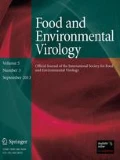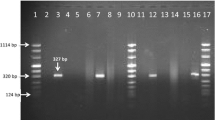Abstract
Various methods to detect foodborne viruses including norovirus (NoV) in contaminated food have been developed. However, a practical method suitable for routine examination that can be applied for the detection of NoVs in oily, fatty, or emulsive food has not been established. In this study, we developed a new extraction and concentration method for detecting NoVs in contaminated composite meals. We spiked NoV-GI.4 or -GII.4 stool suspension into potato salad and stir-fried noodles. The food samples were suspended in homogenizing buffer and centrifuged to obtain a food emulsion. Then, anti-NoV-GI.4 or anti-NoV-GII.4 rabbit serum raised against recombinant virus-like particles or commercially available human gamma globulin and Staphylococcus aureus fixed with formalin as a source of protein A were added to the food emulsion. NoV-IgG-protein A-containing bacterial complexes were collected by centrifugation, and viral RNA was extracted. The detection limits of NoV RNA were 10–35 copies/g food for spiked NoVs in potato salad and stir-fried noodles. Human gamma globulin could also concentrate other NoV genotypes as well as other foodborne viruses, including sapovirus, hepatitis A virus, and adenovirus. This newly developed method can be used as to identify NoV contamination in composite foods and is also possibly applicable to other foodborne viruses.

Similar content being viewed by others
References
Baert, L., Uyttendaele, M., & Debevere, J. (2008). Evaluation of viral extraction methods on a broad range of ready-to-eat foods with conventional and real-time RT-PCR for norovirus GII detection. International Journal of Food Microbiology, 123, 101–108.
Bidawid, S., Farber, J. M., & Sattar, S. A. (2000). Rapid concentration and detection of hepatitis A virus from lettuce and strawberries. Journal of Virological Methods, 88, 175–185.
Borchardt, M. A., Bertz, P. D., Spencer, S. K., & Battigelli, D. A. (2003). Incidence of enteric viruses in ground-water from Household Wells in Wisconsin. Applied and Environmental Microbiology, 69, 1172–1180.
Butot, S., Putallaz, T., & Sánchez, G. (2007). Procedure for rapid concentration and detection of enteric viruses from berries and vegetables. Applied and Environmental Microbiology, 73, 186–192.
Cheong, S., Lee, C., Choi, W. C., Lee, C. H., & Kim, S. J. (2009a). Concentration method for detection of enteric viruses from large volumes of foods. Journal of Food Protection, 72, 2001–2005.
Cheong, S., Lee, C., Song, S. W., Choi, W. C., Lee, C. H., & Kim, S. J. (2009b). Enteric viruses in raw vegetables and groundwater used for irrigation in South Korea. Applied and Environmental Microbiology, 75, 7745–7751.
Dreier, J., Störmer, M., Mäde, D., Burkhardt, S., & Kleesiek, K. (2006). Enhanced reverse transcription-PCR assay for detection of norovirus genogroup I. Journal of Clinical Microbiology, 44, 2714–2720.
Furuta, T., Akiyama, M., Kato, Y., & Nishio, O. (2003). A food poisoning outbreak caused by purple Washington clam contaminated with norovirus (Norwalk-like virus) and hepatitis A virus. The Journal of the Japanese Association for Infectious Diseases, 77, 89–94. [in Japanese].
Goding, J. W. (1978). Use of Staphylococcal protein A as an immunological reagent. Journal of Immunological Methods, 20, 241–253.
Hansman, G. S., Natori, K., Shirato-Horikoshi, H., Ogawa, S., Oka, T., Katayama, K., et al. (2006). Genetic and antigenic diversity among noroviruses. Journal of General Virology, 87, 909–919.
Huang, P., Farkas, T., Zhong, W., Tan, M., Thornton, S., Morrow, A. L., & Jiang, X. (2005). Norovirus and histo-blood group antigens: Demonstration of a wide spectrum of strain specificities and classification of two major binding groups among multiple binding patterns. Journal of Virology, 79, 6714–6722.
Inagawa, W. S., Oshima, A., Aoki, K., Itoh, N., Isobe, K., Uchio, E., et al. (1996). Rapid diagnosis of adenoviral conjunctivitis by PCR and restriction fragment length polymorphism analysis. Journal of Clinical Microbiology, 41, 2113–2116.
Kageyama, T., Kojima, S., Shinohara, M., Uchida, K., Fukushi, S., Hoshino, F. B., et al. (2003). Broadly reactive and highly sensitive assay for Norwalk-like viruses based on real-time quantitative reverse transcription-PCR. Journal of Clinical Microbiology, 41, 1548–1577.
Kessler, S. W. (1975). Rapid isolation of antigens from cells with a Staphylococcal protein A-antibody absorbent: Parameters of the interaction of antibody-antigen complexes with protein A. Journal of Immunology, 115, 1617–1624.
Kim, H. Y., Kwak, I. S., Hwang, I. G., & Ko, G. (2008). Optimization of methods for detecting norovirus on various fruit. Journal of Virological Methods, 153, 104–110.
Kobayashi, S., Natori, K., Takeda, N., & Sakae, K. (2004). Immunomagnetic capture RT-PCR for detection of norovirus from foods implicated in foodborne outbreak. Microbiology and Immunology, 48, 201–204.
Kojima, S., Kageyama, T., Fukushi, S., Hoshino, F. B., Shinohara, M., Uchida, K., et al. (2002). Genogroup-specific PCR primers for detection of Norwalk-like viruses. Journal of Virological Methods, 100, 107–114.
Kroneman, A., Vega, E., Vennema, H., Vinjé, J., White, P. A., Hansman, G., et al. (2013). Proposal for a unified norovirus nomenclature and genotyping. Archives of Virology, 158, 2059–2068.
Langone, J. J. (1982). Applications of immobilized protein A in immunochemical techniques. Journal of Immunological Methods, 55, 277–296.
Latorra, D., Arar, K., & Hurley, J. M. (2003). Design considerations and effects of LNA in PCR primers. Molecular and Cellular Probes, 17, 253–259.
Leggit, P. R., & Jaykus, L. A. (2000). Detection methods for human enteric viruses in representative foods. Journal of Food Protection, 63, 1738–1744.
Logan, C., O’Leary, J. J., & O’Sullivan, O. (2006). Real-time reverse transcription-PCR for detection of rotavirus and adenovirus as causative agents of acute viral gastroenteritis in children. Journal of Clinical Microbiology, 44, 3189–3195.
Loisy, F., Atmar, R. L., Guillon, P., Le Cann, P., Pommepuy, M., & Le Guyader, F. S. (2005). Real-time RT-PCR for norovirus screening in shellfish. Journal of Virological Methods, 123, 1–7.
Mäde, D., Trübner, K., Neubert, E., Höhne, M., & Johne, R. (2013). Detection and typing of norovirus from frozen strawberries involved in a large-scale gastroenteritis outbreak in Germany. Food and Environmental Virology, 5, 162–168.
Morales-Rayas, R., Wolffs, P. F. G., & Griffiths, M. W. (2010). Simultaneous separation and detection of hepatitis A virus and norovirus in produce. International Journal of Food Microbiology, 139, 48–55.
Morton, V., Jean, J., Farber, J., & Mattison, K. (2009). Detection of noroviruses in ready-to-eat foods by using carbohydrate-coated magnetic beads. Applied and Environmental Microbiology, 75, 4641–4643.
Mullendore, J. L., Sobsey, M. D., & Carol Shieh, Y. S. (2001). Improved method for the recovery of hepatitis A virus from oyster. Journal of Virological Methods, 94, 25–35.
Oka, T., Katayama, K., Hansman, G. S., Kgeyama, T., Ogawa, S., Wu, F. T., et al. (2006). Detection of human sapovirus by real-time reverse transcription-polymerase chain reaction. Journal of Medical Virology, 78, 1347–1353.
Oka, T., Mori, K., Iritani, N., Harada, S., Ueki, Y., Iizuka, S., et al. (2012). Human sapovirus classification based on complete capsid nucleotide sequences. Archives of Virology, 157, 349–352.
Oka, T., Wang, Q., Katayama, K., & Saif, L. J. (2015). Comprehensive review of human sapoviruses. Clinical Microbiology Reviews, 28, 32–53.
Park, Y., Cho, Y. H., Jee, Y., & Ko, G. (2008). Immunomagnetic separation combined with real-time reverse transcriptase PCR assays for detection of norovirus in contaminated food. Applied and Environmental Microbiology, 74, 4226–4230.
Rutjes, S. A., Lodder-Verschoor, F., Van der Paul, W. H. M., Van Duijnhoven, Y. T. H. P., & De Roda Husman, A. M. (2006). Detection of noroviruses in foods: A study on virus extraction procedures in foods implicated in outbreaks of human gastroenteritis. Journal of Food Protection, 69, 1949–1956.
Sair, A. I., D’Souza, D. H., Moe, C. L., & Jaykus, L. A. (2002). Improved detection of human enteric viruses in foods by RT-PCR. Journal of Virological Methods, 100, 57–69.
Schwab, K. J., Neill, F. H., Fankhauser, R. L., Daniels, N. A., Monroe, S. S., Bergmire-Sweat, D. A., et al. (2000). Development of methods to detect “Norwalk-like viruses” (NLVs) and hepatitis A virus in delicatessen foods: Application to a food-borne NLV outbreak. Applied and Environmental Microbiology, 66, 213–218.
Sherer, K., Johne, R., Schrader, C., Ellerbroek, L., Schulenburg, J., & Klein, G. (2010). Comparison of two extraction methods for viruses in food and application in a norovirus gastroenteritis outbreak. Journal of Virological Methods, 169, 22–27.
Stals, A., Baert, L., De Keuckelaere, A., Van Coillie, E., & Uyttendaele, M. (2011a). Evaluation of a norovirus detection methodology for ready-to-eat foods. International Journal of Food Microbiology, 145, 420–425.
Stals, A., Baert, L., Van Coillie, E., & Uyttendaele, M. (2011b). Evaluation of a norovirus detection methodology for soft red fruits. Food Microbiology, 28, 52–58.
Stals, A., Baert, L., Van Coillie, E., & Uyttendaele, M. (2012). Extraction of food-borne viruses from food samples: A review. International Journal of Food Microbiology, 153, 1–9.
Suffredini, E., Pepe, T., Ventrone, I., & Croci, L. (2011). Norovirus detection in shellfish using two real-time RT-PCR methods. New Microbiologica, 34, 9–16.
Teunis, P. F. M., Moe, C. L., Liu, P., Miller, S. E., Lindesmith, L., Baric, R. S., et al. (2008). Norwalk virus: How infectious is it? Journal of Medical Virology, 80, 1468–1476.
Tian, P., Engelbrektson, A., & Mandrell, R. (2008). Two-log increase in sensitivity for detection of norovirus in complex samples by concentration with porcine gastric mucin conjugated to magnetic beads. Applied and Environmental Microbiology, 74, 4271–4276.
Acknowledgments
This study was supported by grants for Research on Food Safety from the Ministry of Health, Labour, and Welfare of Japan. We sincerely thank Dr Naokazu Takeda from the Research Institute for Microbial Diseases, Osaka University, for providing technical advice and reviewing a draft protocol of this study. We thank Dr Tomoichiro Oka from the Department of Virology II, National Institute of Infectious Diseases for his review of the manuscript.
Author information
Authors and Affiliations
Corresponding author
Rights and permissions
About this article
Cite this article
Saito, H., Toho, M., Tanaka, T. et al. Development of a Practical Method to Detect Noroviruses Contamination in Composite Meals. Food Environ Virol 7, 239–248 (2015). https://doi.org/10.1007/s12560-015-9191-7
Received:
Accepted:
Published:
Issue Date:
DOI: https://doi.org/10.1007/s12560-015-9191-7




